Given that most gardeners are as opportunistic as weeds—give us an inch and we’ll plant it—it’s surprising how many of us have not gotten around to filling our garden’s tiniest peripheral gaps. After all, opportunities abound in neglected corners, along narrow sidewalks, in driveway cracks, within tree root notches, against immovable rock outcrops, and tucked into stone walls and ledges. Any vacancy that’s fair game for a weed is fair game for the gardener. Perhaps the most compelling reason, in fact, to plant nooks and crannies is to prevent weeds from filling them for us. It’s ironic, then, that the right plants for tight spaces often have a lot in common with the very weeds we might hope to suppress: They must be vigorous against all odds; tough-as-nails, to endure confinement without suffering; and as opportunistic as we are. It’s actually necessary to view plants’ ability to spread and self-sow as advantages in our garden’s favor rather than as annoying liabilities. The plants should be encouraged to seed themselves into their preferred spots as if nature assisted with the garden design. Gardeners simply need to pay attention (which we do anyway) and remember that we are allowed to exercise full editorial control. Besides being all-around prettier, our own selections will differ from weeds in their compact growth, their tidiness of habit, and the fact of their being shallow rooted or otherwise easy to pluck out whenever we disapprove of their placement.
For the shade, choose woodland plants, wildflowers, and even houseplants
For humus-rich nooks that might pocket fallen leaves, tuck in shallow-rooted plants that would otherwise thrive in a temperate- or, in the case of houseplants, tropical-forest understory. Choose plants that appreciate a slightly lower pH (more acidic) than average garden soil, a cool root zone, and even moisture.
Shady Selections Like a Cool Root Zone
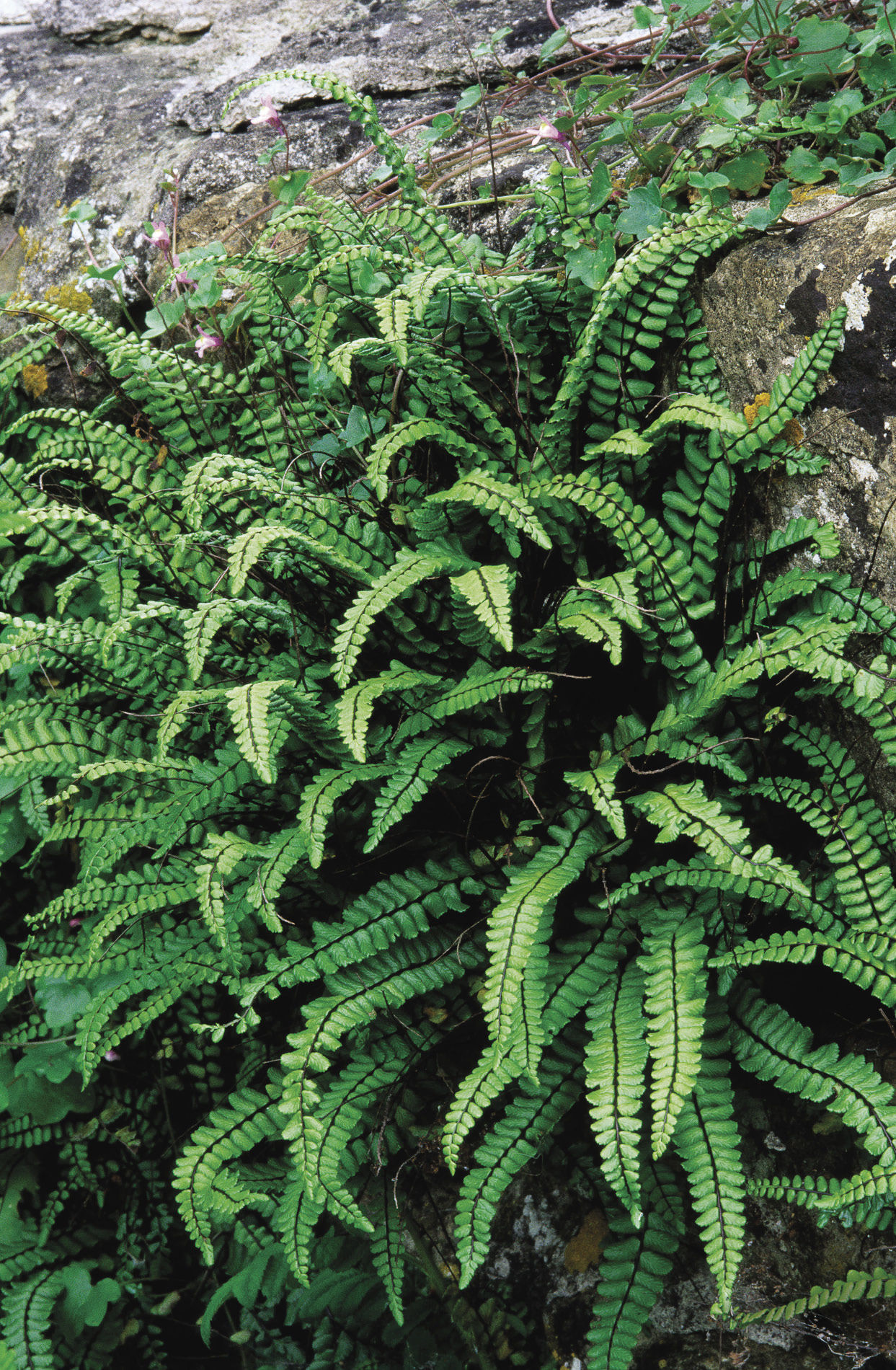
Maidenhair spleenwort (Asplenium trichomanes, USDA Hardiness Zones 5–8), which, like any fern, will instantly give your garden a been-here-since-the-dawn-of-time feeling, is actually an exception to the just-mentioned rule. Its requirements for high pH and sharp drainage make it perfect for planting next to dappled or fully shaded cement walkways or into mossy mortared walls. Clumps of wiry, 3- to 6-inch-long fronds lined with oval, evergreen buttons will spread slowly to about 8 inches wide from a shallow rhizome.
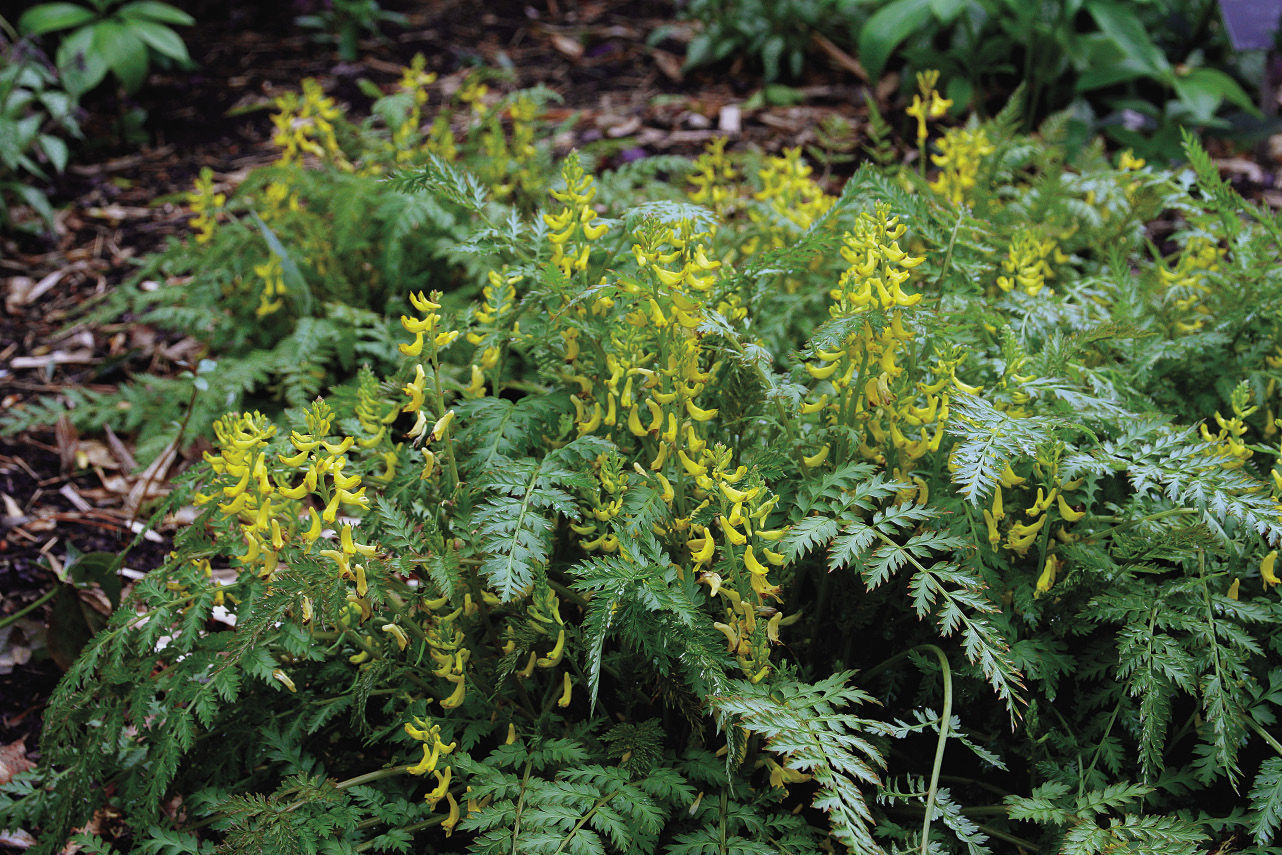
I like to think of fernleaf corydalis (Corydalis cheilanthifolia, Zones 4–9) as the golden thread that stitches the crazy quilt of the garden to its plain backing. This evergreen perennial looks as prehistoric as a fern but is more interesting for sending up delicate yellow flowers from spring into summer from its 6- to 12-inch-tall tufts of bronzy foliage. It seeds itself into all the best cracks and into rock walls but allows the gardener ultimate editorial control by being easy to pluck out. Its favored ground is any fertile, evenly moist cranny in full sun to partial shade.
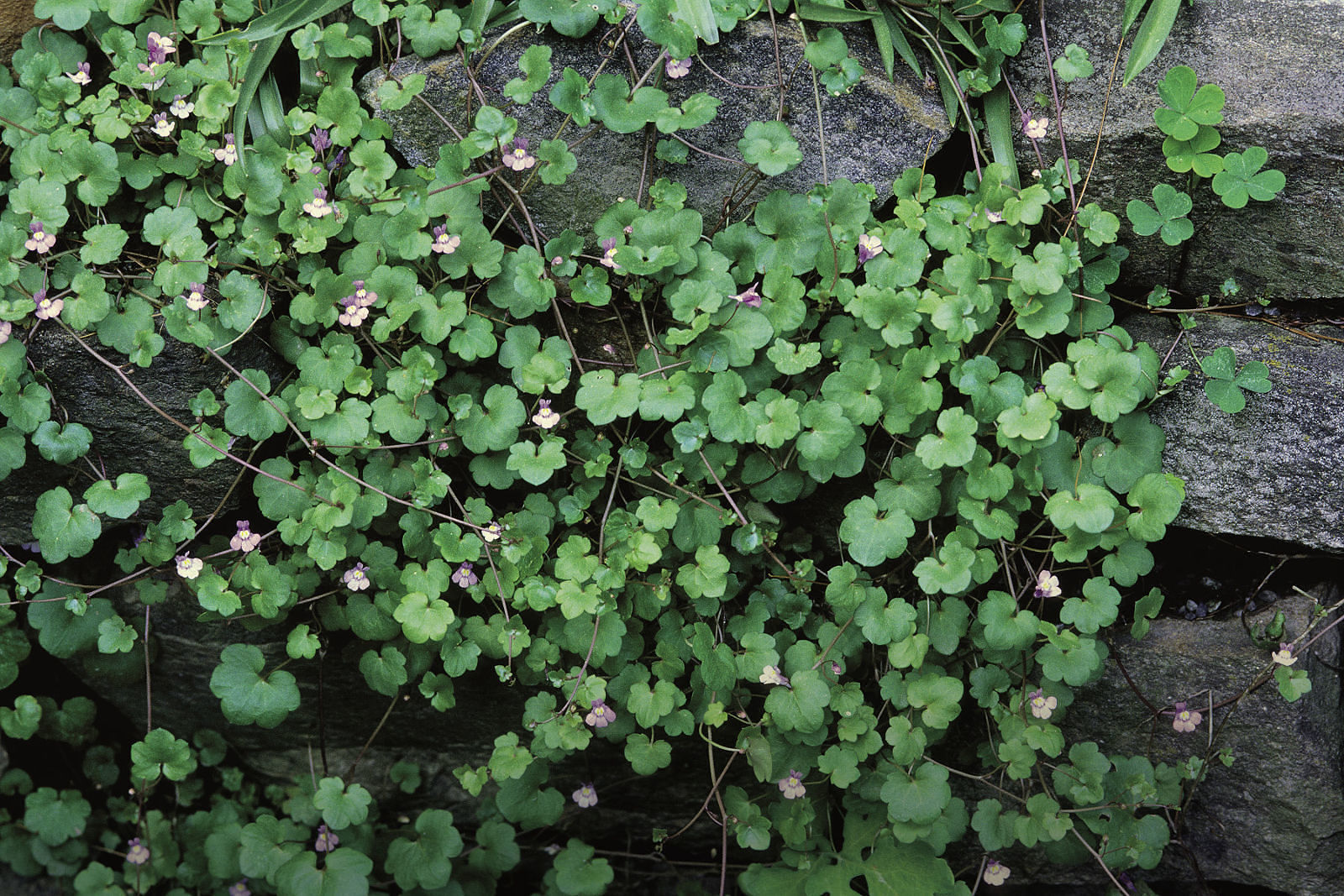
Because Kenilworth ivy (Cymbalaria muralis, Zones 4–8) is a rampant weed in the gravel floor of our greenhouse, I was tempted to remove it when I caught it in the garden. But its cumulus cloud–shaped leaves and diminutive, nimbus cloud–colored flowers can be encouraged, instead, to drape as quietly as fog over a rock wall and drip lushly from its pockets. The loose change–size leaves and tiny flowers form a 2-inch-tall blanket up to 12 to 18 inches wide. It prefers partial shade and will sow itself into the most ideal places while being perfectly easy to weed out.
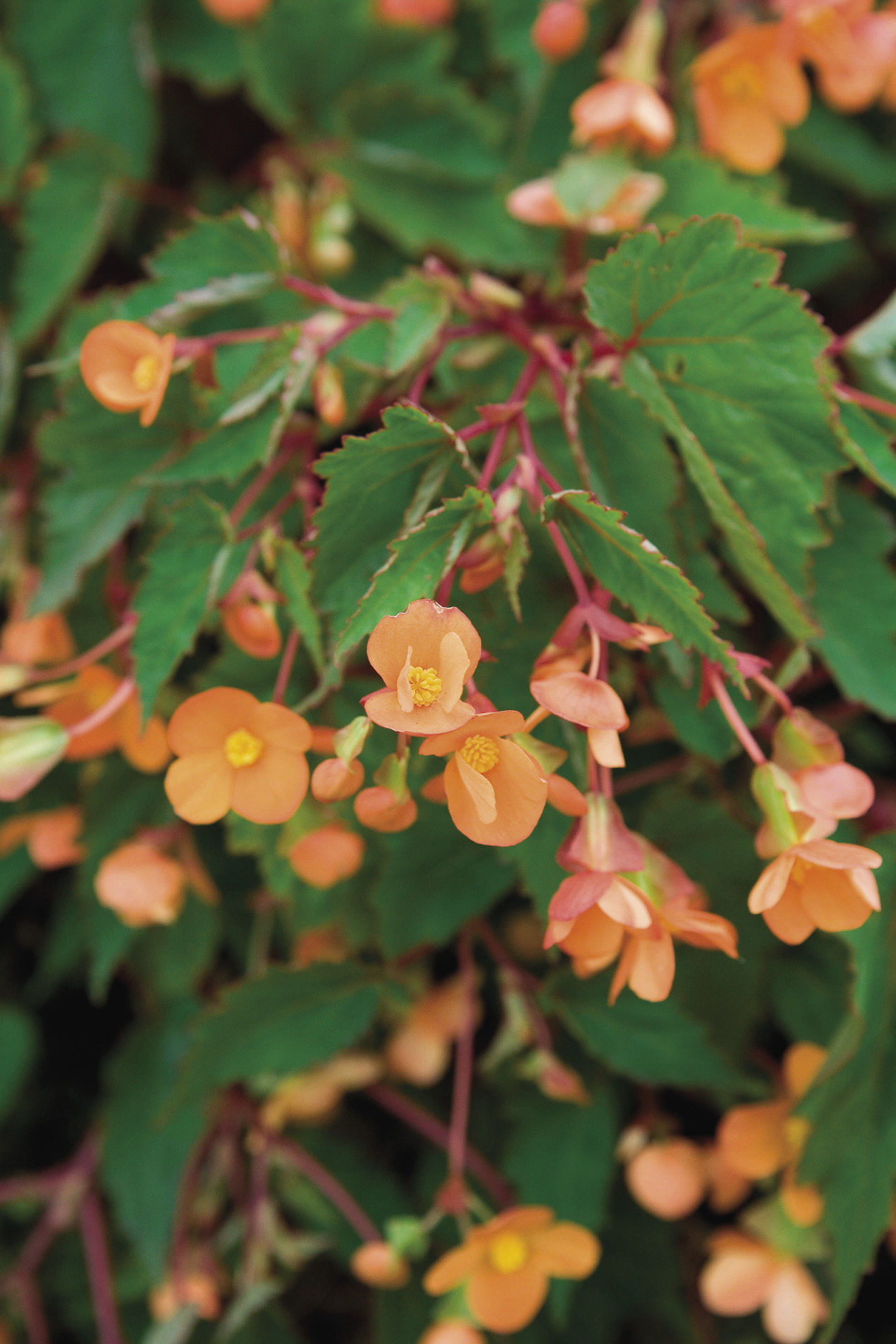
Tuberous Sutherland’s begonia (Begonia sutherlandii, Zones 8–11) illuminates any partially shady nook with 6- to 18-inch-tall cascades of grass green leaves with red-orange veins and an entire summer’s worth of orange sorbet–colored flowers. As with fellow begonia species, it may go dry but shouldn’t stay dry. It dies to the ground over winter, and where it isn’t hardy, it may be potted up, kept cool, and allowed to dry out and die back until it starts up again on its own in spring. Begin to water as spring growth breaks, and replant it in a nook shaded from midday sun, after nighttime temperatures are above 50°F.
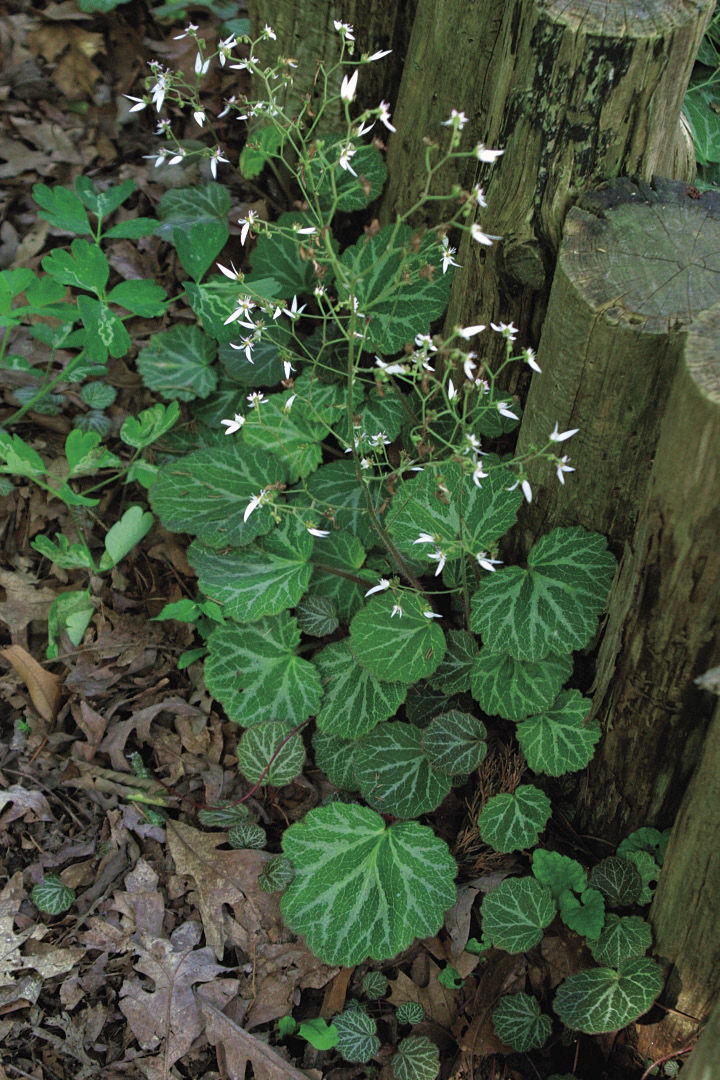
The most fascinating thing about strawberry begonia (Saxifraga stolonifera, Zones 6–9) is how it spreads: by forming tiny new plants at the very end of thin red stolons. Plants hug the ground in shady nooks and send shooting-star flowers skyward on loose, 1-foot-tall stems in midsummer. There’s nothing cuter than positioning the “mother of thousands” where her daughters can dangle. For a Saxifraga, it is not at all fussy about soil alkalinity, and it requires only humus-rich, well-drained soil year-round and protection from scorching summer sun.
For sun, try succulents and alpine and rock-garden plants
For sunny, sharply drained crevices, look to plants that can’t stand wet feet. All plants need water, but most denizens of the desert and of alpine scree will thrive only when they are allowed to dry out quickly after a drenching. In general, rock-garden plants and succulents also appreciate the high pH leached from stone walls, mortar, and cement foundations and can tolerate a baking summer sun.
Small Sunny Spots have Colorful Options
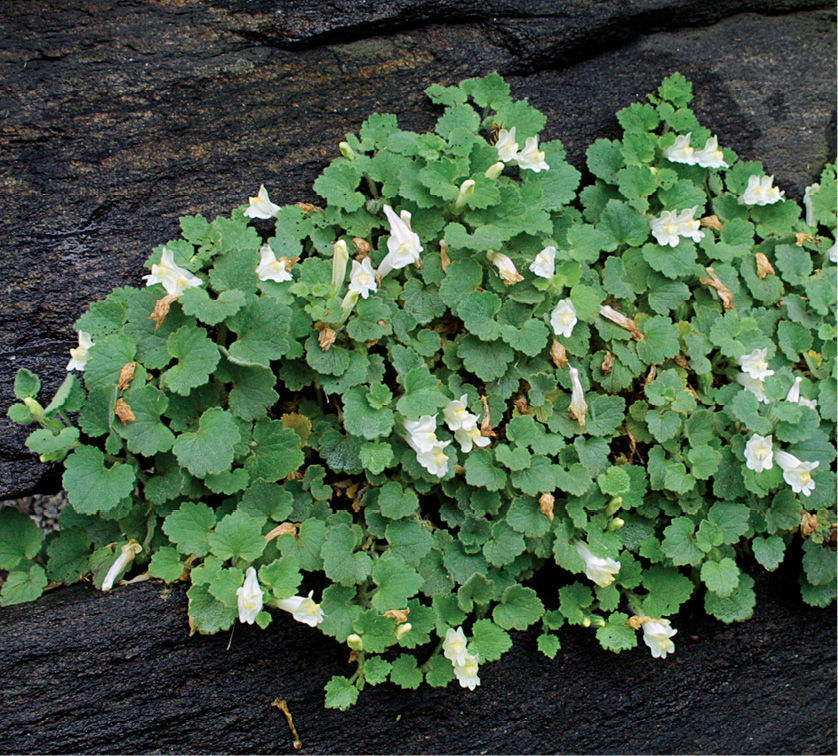
It never would have even occurred to me to tuck climbing snapdragon (Asarina procumbens, Zones 6–9) into a rock wall. It planted itself there, apparently preferring the vertical to the horizontal. Do as I do now and plant it at the top of a retaining wall, and watch it repel seeds down to drape elegantly from open crevices or recline along the wall’s base in a mere thimbleful of soil. Pout-lipped, incandescent, pale yellow flowers appear from May to frost from 2-inch-tall and 2-foot-wide mats of soft, evergreen, grayish green foliage. It will seek partial shade from the hottest summer sun and evidently requires nothing aside from excellent drainage.

‘Tiny Rubies’ pink (Dianthus ‘Tiny Rubies’, Zones 4–8, photo 2, p. 49) flaunts early-summer flowers in a color somewhere between Bazooka-bubble-gum pink and pale purple atop a 4-inch-tall blue muffin of foliage. It is a must-have plant for any garden, but it will only do well with plenty of sun and sharp drainage. It is best appreciated when it’s isolated from potential overtakers. It can be grown through the gravel at the edge of a walk or, better yet, along the top of a wall, where its heavenly scented flowers can be appreciated.
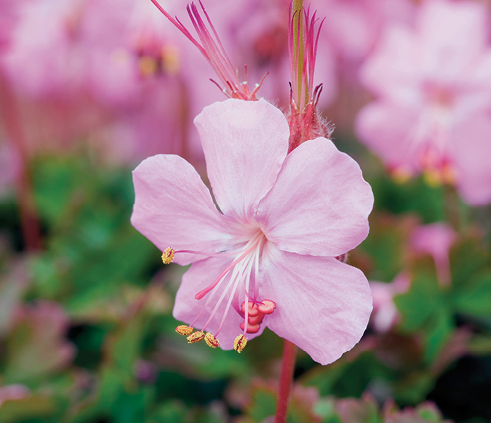
Hardy geraniums are already famous for being excellent, tough-as-nails ground covers. Dalmatian cranesbill (Geranium dalmaticum, Zones 5–7, photo 3, p. 49) is particularly ideal for nooks and crannies because it not only tolerates drought but also thrives in sharp drainage. Dalmatian cranesbill forms a dense, gently spreading, 6-inch-tall and 20-inch-wide mound of smooth, scallop shell–shaped leaves that turn barn red and purple in fall. Pale pink flowers hover in clusters above the foliage in summer. Plant it in noncompetitive solitude (for a tough plant, it’s pretty dainty) in a mostly sunny, shallow, well-drained cranny wide enough for it to stretch its rhizomes. Rejuvenate old, tired-of-blooming plants by breaking out the center and replanting the edges.
Good Drainage Helps Sun Lovers
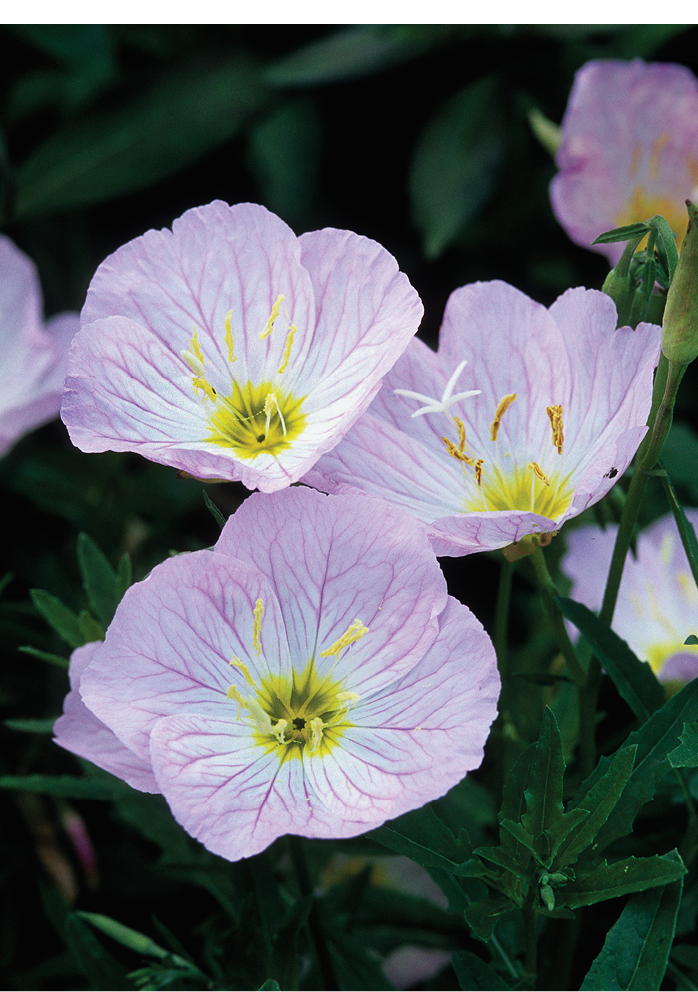
Given the right conditions—from dry to moist, well-drained soil—‘Siskiyou’ Mexican evening primrose (Oenothera speciosa ‘Siskiyou’, Zones 5–8) has the potential to infuriate any gardener by insinuating itself into and around the crowns of neighboring plants and swallowing entire garden beds with its vigorousness. That said, it is the absolute best plant (wherever it isn’t on an invasive list) to live where other plants fear to tread—say, off by itself in a confined crevice alongside a driveway, up against a wall, or surrounded on all sides by pavement. It thrives in sunny heat; shrugs off pollution; and offers a conciliatory early-summer display of 2-inch-wide, teacup-shaped pink flowers balanced 20 inches tall, atop narrow leaves. It will die to the ground over winter and may never return if its ground is boggy.
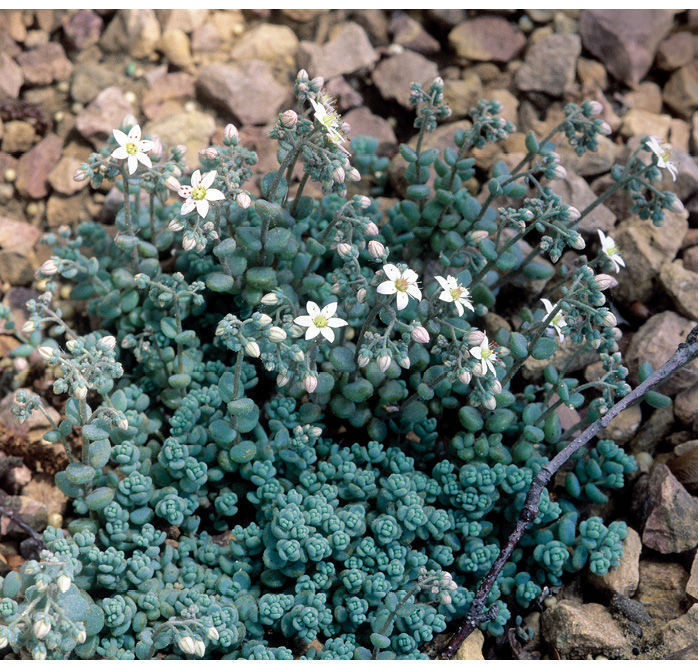
Corsican stonecrop (Sedum dasyphyllum, Zones 3–7) is another plant that takes extremely well to a hot rock wall and willingly inhabits shallow, free-draining pockets with very little soil. Tightly packed, succulent, blue-green leaves form a dense carpet of tufts so tiny that their size is measured in fractions of an inch, and in early summer, the plant produces eggs-sunny-side-up flowers from clumps of pink buds. Although it spreads freely by stem rooting and breakage, I would hesitate to call it aggressive because of its lilliputian dimensions and easy removal.

Chinese dunce cap (Orostachys iwarenge, Zones 5–10) is a mat-forming, pavement gray succulent that goes incognito along a rock wall until late summer, when salmon pink flower towers rise from the rosette centers. Like most succulents, Chinese dunce cap needs sharp drainage, and it will flower and produce a bazillion offsets when planted in full sun. It can get by with a paltry amount of soil and, when planted in rock-wall pockets, will catch the amused eye of only the truly observant. For vigor and blooms, choose a west-facing pocket to plant in to catch the heat of the afternoon sun.
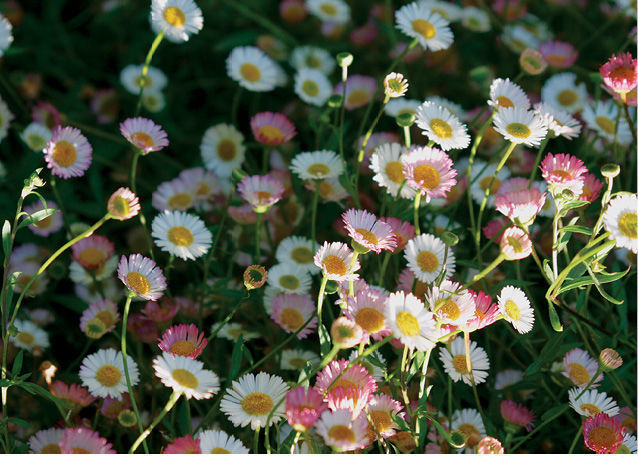
There is conflicting information about the hardiness of fleabane (Erigeron karvinskianus, Zones 7–9), and because it has never returned in our gardens despite ample opportunity, I’m inclined to call it “tender.” It does, however, self-sow madly in containers that overwinter in our cool (but never freezing) greenhouse. Where this plant is hardy, it may border on being aggressive. It spreads as well as self-sows, and it will be most appreciated for its vigor by placing itself in otherwise inhospitable dry cracks and crevices. A profusion of white daisies open throughout summer and fade into a multicolored array of pinks above fuzzy, deep green foliage. It flows in frothy, 6-inch-tall waves up to 3 feet wide. Fleabane needs full sun for lots of blooms, and it requires sharp drainage, particularly through winter, for survival.

With succulent rosettes so readily available in a painter’s palette of colors and a dime-store variety of sizes (from fractions of an inch to 4 to 5 inches across), it’s no wonder that hens and chicks (Sempervivum spp. and cvs., Zones 4–11) is the ubiquitous choice for any gardener with a hot, dry-as-a-bone, free-draining patch of ground to fill. Just because it is the obvious choice doesn’t mean it’s not the best—because it weaves the finest tapestry, especially when paired with its sister: sedum (Sedum spp. and cvs., Zones 3–11). It has no preference for plane, increasing as readily on a vertical face as along a horizontal surface, and it will never balk at being abusively divided and muscled into tight spaces so long as it is watered in.
Now, when you look out at your garden’s empty nooks or weedy crannies, notice how they could, instead, showcase something precious, and use this list of my favorites as fuel for your wildest imagination.
Planting in Crevices is Simple
One-hundred-year-old trees and mature shrubs are not the only plants that ground a garden and give it a grandparent’s gravitas. A thoughtful selection of unique annuals and perennials poked into nooks and crannies will knit a garden’s youthful skin to its old bones. Here’s how to make it happen:

1. Prepare your pocket
Once you’ve found your planting crevice, loosen any soil that’s present to make room for your new plant.
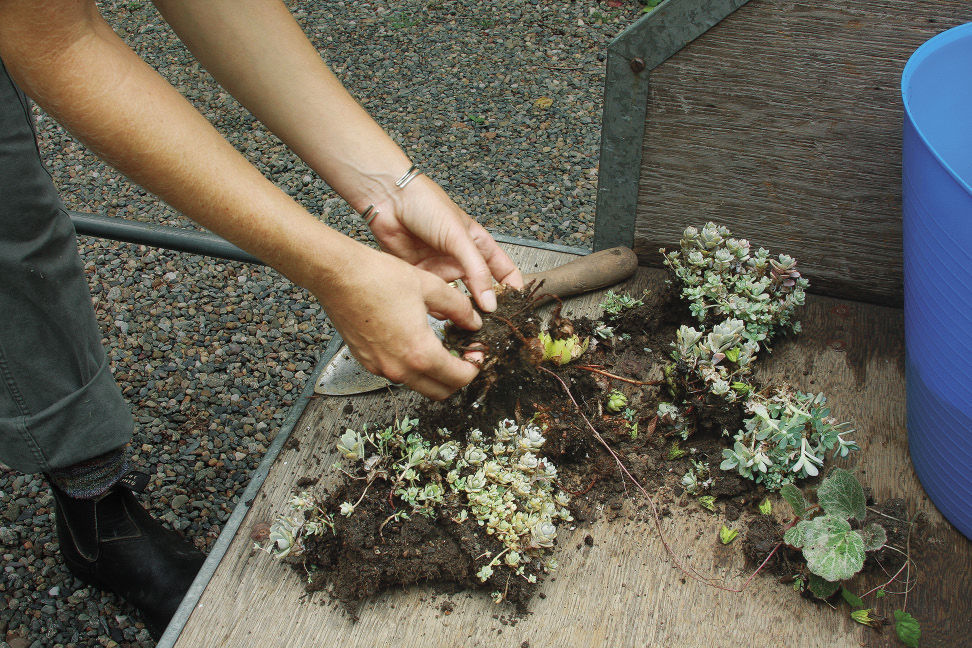
2. Prep your plant
Plants will grow quickly to fill their space, so start with as small a plant or division as possible to make planting easier. Remove as much soil as necessary from the roots to make it easier to wiggle them into your tight space.
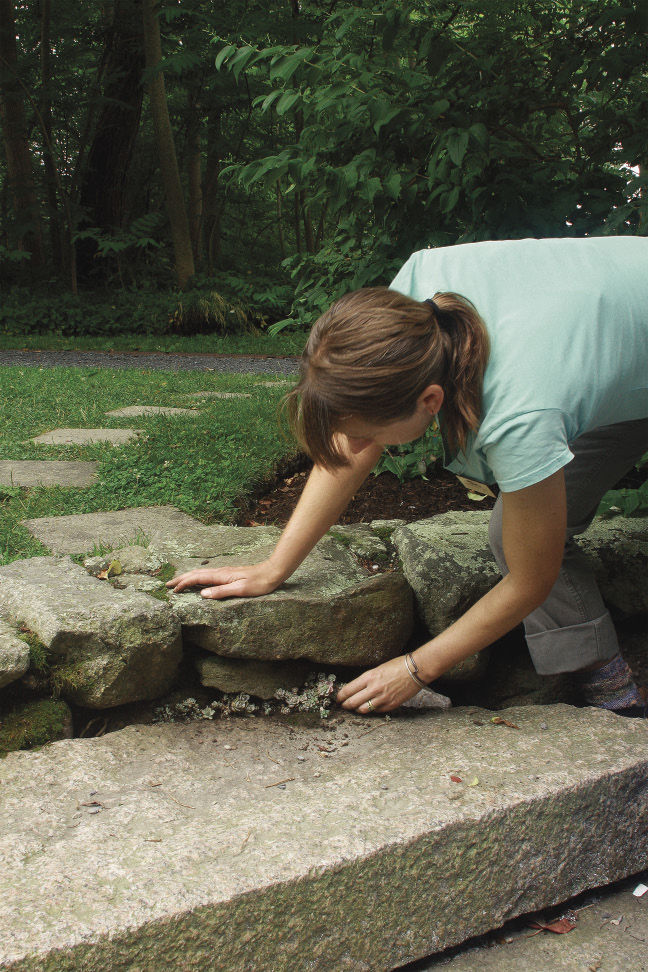
3. Nestle the roots in
Gently cram the roots into your hollowed-out crevice. Replace as much soil as necessary to anchor them there, remembering to add sand or compost to suit the plant’s cultural requirements.
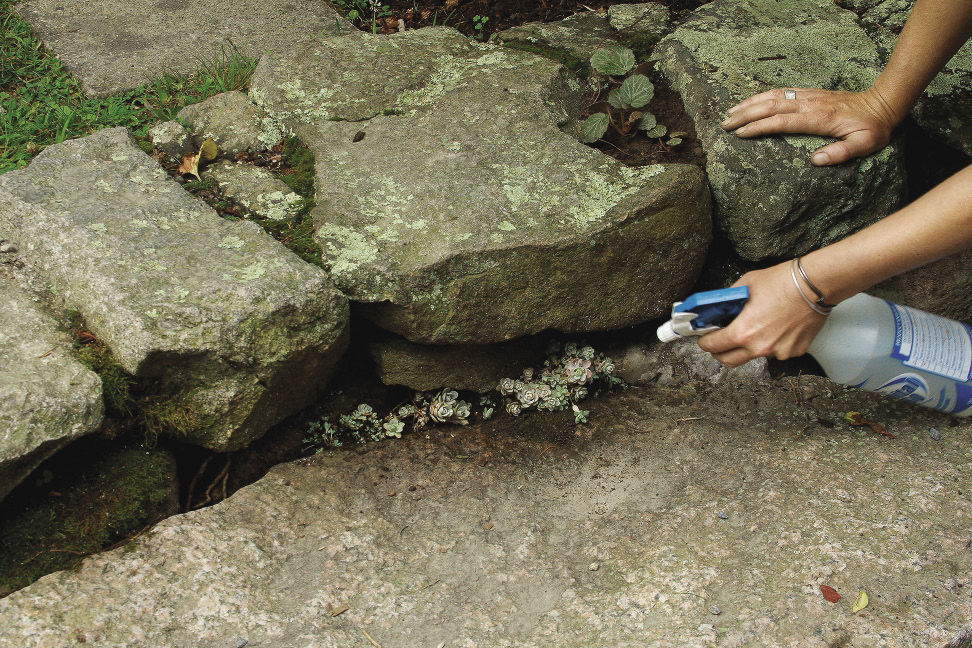
4. Water it in
Water the plant in using a method that will deliver water to the crevice without washing the plant and the soil back out again. I like to spritz a new planting thoroughly with a spray bottle rather than blasting it with a hose.
Explore the plant possibilities
Want to find more plants that will work in your cracks and crevices? Here are some common characteristics of plants that flourish in tight quarters:
▶ They require good to sharp drainage.
▶ They are exceptionally drought tolerant.
▶ They like neutral to alkaline soil pH. This is particularly important for plants for cracks in pavement or mortar.
▶ They have shallow or fibrous roots.
▶ They will stay tidily in scale, even when full grown.
▶ Bonus characteristic:
Self-seeders are the best for ensuring, over time, an uncontrived, mature yet whimsical, natural look.
Kristin Green is an interpretive horticulturist at Blithewold Mansion, Gardens & Arboretum in Bristol, Rhode Island.
Photos: Michelle Gervais; John Glover/www.gapphotos.com; Bill Johnson; Sarah Cuttle/www.gapphotos.com; Martin Hughes-Jones/www.gapphotos.com; Jennifer Benner; Geoff Kidd/www.gapphotos.com; Nancy J. Ondra
Sources
The following mail-order plant and seed sellers offer the widest selection of the plants featured:
Annie’s Annuals & Perennials, Richmond, Calif.; 888-266-4370; www.anniesannuals.com
Arrowhead Alpines, Fowlerville, Mich.; 517-223-3581; www.arrowhead-alpines.com
Avant Gardens, Dartmouth, Mass.; 508-998-8819; www.avantgardensne.com
Big Dipper Farm, Black Diamond, Wash.; 360-886-8253; www.bigdipperfarm.com
Lazy S’S Farm Nursery, 2360 Spotswood Trail, Barboursville, VA 22923; www.lazyssfarm.com
Thompson & Morgan, Aurora, Ind.; 800-274-7333; www.tmseeds.com



















Comments
Log in or create an account to post a comment.
Sign up Log in